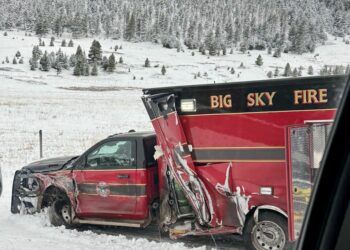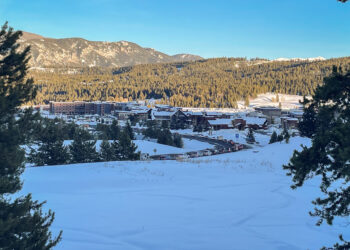By Taylor Owens CONTENT MARKETING LEAD
As winter’s cold grips disperse in the coming weeks, bears will begin the process of waking up from hibernation. With the end of hibernation season on the horizon, the focus will shift to the crucial role of the public in mitigating conflicts between bears and humans. This season, bear safety and awareness is more important than ever as we enter into a new era of grizzly bear population success and expanding bear territory.
“We actually don’t know what cues they take that get them to wake up in the springtime, but there is a pretty consistent pattern of hibernating beginning in November and emergence happening usually March, April and May,” said Danielle Oyler, wildlife outreach specialist for Montana Fish, Wildlife and Parks.
Bears hibernate as a response to a lack of food. Hibernation is a way to save energy during times of scarcity, and in North America, scarcity accompanies winter. Factors that determine how long a bear hibernates include age, gender and reproductive status. As of the 2023-24 winter season, bears in Montana have been consistent in their hibernation schedules.
“It’s an El Niño winter, but we haven’t noticed anything different with the bears,” Oyler said. “They have been on their normal cycle. Typically, bears will hibernate for a similar amount of time every year. There can be variability, especially in the fall with specific bears, if they have become accustomed to a food source that remains longer than maybe it does in other areas. So that’s something that does happen, but it’s usually not for a whole population of bears.”
Hibernation variability is not a usual occurrence but can occur in specific cases. One such case could be that a bear is not fat enough to make it through the winter. That bear may wake up because they are hungry, but that is not a normal or healthy occurrence.
“There can be bears that wake up occasionally,” Oyler said. “It’s pretty unusual, but bears can wake up in the middle of hibernation and then go back into the den. If they’re not going to make it through winter and they’re in a desperate attempt to find food, they might not make it. It is the exception and not the rule.”
The biggest task ahead for the public and people living in bear country is food storage and keeping attractants away from bears. These are the most important undertakings to keep bears out of trouble and safe, as well as keep people safe, as we approach emergence.
Most bear conflicts are related to attractants, whether that is bears getting into garbage or food waste that was left out. Keeping attractants away from bears is important for property owners, vacation renters, hotel guests and anyone living or staying in bear country.
“I think folks visiting Big Sky don’t necessarily expect that a grizzly bear could walk through their backyard, but they definitely can, and do,” Oyler said. “So it’s always good to assume that they’re there, even if you don’t see them.
The best ways to impact your local wildlife is to take responsibility back home and evaluate your property and make sure everything is stored properly. Another important reminder, going into spring, is to put away bird feeders so bears do not get into them.
“It’s more important than ever that we all do our part this year to help bears share the landscape safely with people,” said Matthew Hart, communications director at Vital Ground Foundation. “That means everything from carrying bear spray and practicing its proper use to homeowners and landowners in grizzly country securing any possible bear attractants on their properties.”
By almost any measure, the recovery of grizzly bear populations in the Rocky Mountain West has been successful. Because of this, the bruins are moving into new places, looking for home ranges, and they’re showing up in places people haven’t seen them in in a long time.
“People should expect to see grizzly bears anywhere west of Billings, Montana,” Oyler said. “That doesn’t mean that there’s the same density everywhere in the state, but we are seeing grizzly bears moving into new places.”
Grizzly bear density in the Greater Yellowstone Ecosystem is highest at the core of that ecosystem and the surrounding mountain ranges, including our neighboring Absaroka, Beartooth, and Gallatin ranges.
“If you imagine the core of the ecosystem is like a cup of water and now the cup is full,” Oyler said. “When you pour more water in the cup, it spreads out. That’s what’s going on with the bears.”
“If you think about where conflicts are more likely to happen, especially if they’re related to attractants and food, it’s going to be at the edges,” Oyler continued.
As bears continue to expand into new areas, there are more places and opportunities for them to find attractants and interact with people than there are in the core of their ecosystems. Proper storage of attractants has been a priority at the core of these ecosystems for a long time.
“The forest service and the park service have put in bear resistant containers and have a done a really good job of trying to get that message out and help their visitors do the right thing with their attractants,” Oyler said. “But at the edges, that’s a bit more challenging because it’s a mix of public and private land and agriculture and it becomes more complicated.”
More education and awareness on how-to live-in bear country will be needed in areas bears are now appearing in. Bear safety and education is more important than ever for longtime residents and visitors of this region of Montana.
This article is part of a partnership with Hey Bear. Organizations like Hey Bear, alongside partnering nonprofits like Vital Ground Foundation, work to spread awareness and safety tips about living in bear country, and protect and restore North America’s grizzly bear populations for future generations by conserving wildlife habitat and by supporting programs that reduce conflicts between bears and humans. Learn more at heybear.com.













